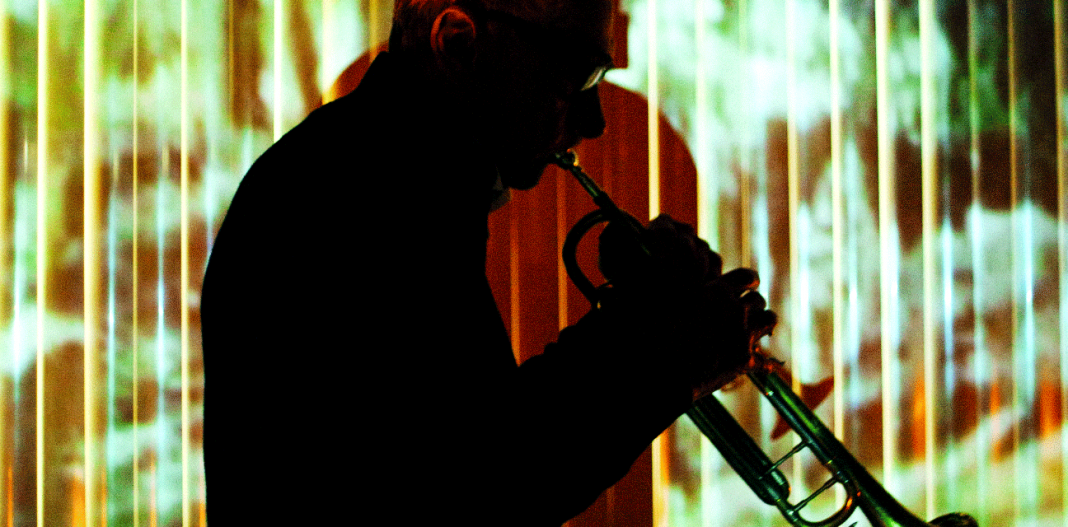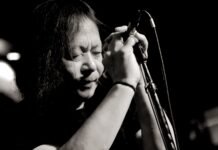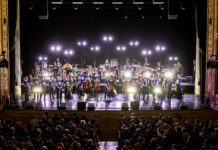Cover photo: Roman Koval (Jon Hassell)
First published in German in Groove 173 (July/August 2018).
“Like the video technique of ‘keying in’ where any background may be electronically inserted or deleted independently of foreground, the ability to bring the actual sound of musics of various epochs and geographical origins all together in the same compositional frame marks a unique point in history.” So wrote the New York trumpeter and composer Jon Hassell in the liner notes to his album Aka / Darbari / Java. The year is 1983 and the „unique point in history“ Hassell refers to is the advent of digital sampling, a technique which he’s just made extensive use of on his new album. Remarkable for an artist working with a technology then still in its infancy, Hassell immediately recognized the potential of sampling as a new musical paradigm.
Or perhaps not all that remarkable. Having previously played and studied with Karlheinz Stockhausen, La Monte Young, Terry Riley and Pandit Pran Nath, Aka / Darbari / Java was already Jon Hassell’s fifth album and the finest distillation yet of an aesthetic he had been working in for several years; an approach to music making that in conception and spirit anticipated the blurring of chronology and geography that sampling was just then making possible in the digital realm.
Hassell called the music he was inventing “Fourth World” and defined it as combining features of traditional musics from around the globe with advanced electronic techniques. In its highest form the blend of influences would create the impression of a new, unified sound. Crucially, Hassell was careful to differentiate his projects from what he called “cosmetic” Fourth World – conventional musical statements with borrowed flavorings of exotic instruments, as well as from “covert” Fourth World – structural framework of non-Western music borrowed and presented with Western orchestration.
Hassell’s earliest albums, made without the use of sampling technology – Vernal Equinox (1978), Fourth World Vol.1 – Possible Musics (1980), and Dream Theory In Malaya (1981) – were anything but latter-day updates to the exotica canon, nor were they jazz, ambient, minimalism, electronic music or ethnomusicological research. Instead, his was a much stranger brew that deployed all of the these elements to arrive at music that was “not entirely primitive, not entirely future but someplace impossible to locate either chronologically or geographically.”
Each album was an immersion in a richly detailed, mysterious and sensual world – and there was nothing like them at the time (nor is there now). One listener who picked up a copy of Vernal Equinox and was particularly impressed was ex-Roxy Music member and ambient innovator Brian Eno. After befriending Hassell, Eno went on to co-produce three albums with him and recycle many of the ideas he had picked up in the process for My Life In The Bush of Ghosts – a collaboration between Eno and Talking Heads’ David Byrne. (Hassell was originally involved before he left the project due to artistic differences.)
Throughout the 80s, 90s and 2000s, Hassell continued to expand his sound into ever more lushly abstracted zones with the albums Power Spot, The Surgeon Of The Night Sky Restores Dead Things By The Power Of Sound, Maarifa Street and Last Night The Moon Came Dropping Its Clothes In The Street. The recently re–released City: Works Of Fiction from 1990 was a step into decidedly dancier territory and included a bona fide house track, “Voiceprint” – released at the time as a 12” with remixes by 808 State. Throughout this period, Hassell’s influence continued to spread, and he appeared on recordings by Peter Gabriel, David Sylvian, Hector Zazou, David Toop, and Ry Cooder, among others.




![[REWIND2023] Platten der Woche: Fünf für den Klassik-Floor](https://groove.de/wp-content/uploads/2023/12/PdW_2023_KW51-218x150.jpg)
